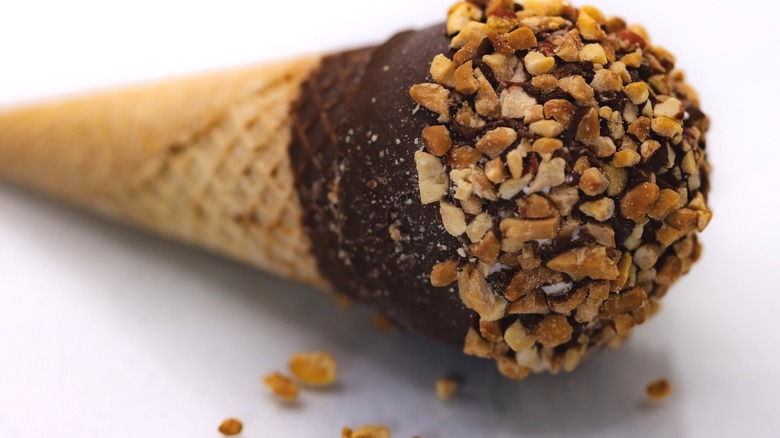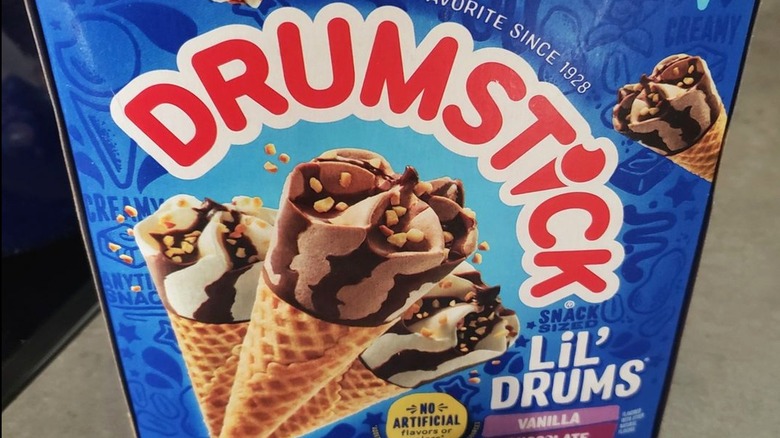No, Drumsticks Aren't Actually Made With Real Ice Cream
You can't go down a frozen aisle or visit an ice cream truck without finding a Drumstick. Invented in 1928, Drumsticks were meant to replicate the vanilla ice cream-topped sugar cones that were popular at county fairs but sold pre-packaged. Nestlé, which partnered with Drumstick in 1991, claims that the "accidental" origin of Drumsticks happened when founder I.C. Parker dropped his ice cream cone in a vat of chocolate, fished it out, and placed it on a countertop coated in peanuts.
The story is disputed. In reality, the inventors of the Drumstick had some difficulty getting the pre-packaged vanilla cones to hold up and not melt immediately. So with the help of some food scientists, the company decided to add the hard-shell chocolate coating that is now a key part of the iconic Drumstick experience, as well as a sprinkling of peanuts. With these additions, folks could enjoy ice cream cones anywhere without a fresh scoop of vanilla on hand ... sort of. Despite their inspiration being, obviously, ice cream, Drumsticks aren't actually ice cream themselves.
But there's milk, and it's icy cold, isn't it? Though Drumsticks started out as a variation on good old-fashioned ice cream, they are actually defined as a frozen dessert. According to the USDA, real ice cream has to contain at least 10% milk fat, and Drumsticks don't meet this qualification. To be sure, Drumsticks contain some dairy such as milk, and cream, and dairy product solids, but not enough to make them ice cream.
What are they actually made out of?
These creamy frozen desserts may not be made up entirely of milk and cream, but Drumsticks sure seem to taste like ice cream, right? But much of the flavor, texture, consistency, and fat comes from non-dairy sources. Drumsticks are made up of coconut, palm, and soybean oil, which is probably why you don't notice the lack of dairy-sourced fat, and why it's so hard to believe Drumsticks aren't actually ice cream. If you're evaluating which frozen desserts you should or shouldn't buy, starting with the ingredients is always a good first step.
Dessert companies frequently choose to use other fat sources for their products for a variety of reasons. Sourcing dairy can be expensive and comes with strict regulations, so plant-based oils are often much easier to use. Plant-based oils also reduce the fat percentage, and thereby caloric content, which can make them more appealing to dieters and seen as a healthy alternative to real ice cream. You'll also note that the use of these lower fat oils can also cause the ice cream to freeze harder than traditional ice cream, which means that Drumsticks can better hold their shape without melting; an early issue for the frozen treat.
Are frozen desserts worse for you than ice cream?
There's plenty of fear-mongering out there about what foods to avoid, particularly if they don't qualify as what we consider the most authentic, classic version of something. The knee-jerk reaction to hearing that Drumsticks aren't ice cream, despite looking and tasting like it, might be that it's some nasty byproduct, but this isn't reasonable or true. Plant-based fats might not make these frozen desserts true ice cream, but that's because the USDA's definition is fairly arbitrary and meant to regulate dairy products. Frozen dessert isn't code for anything nefarious. Vegan ice creams, as well as frozen yogurt, which are yogurt rather than cream-based, also wear the label of frozen dessert, simply because they don't contain any milk fats (and, we've even ranked popular dairy-free ice creams, worst to best). So no, despite its classification as a frozen dessert, there's nothing inherently bad about enjoying Drumsticks.
In fact, the reduced animal fat content typically makes for a dessert lower in cholesterol as well as saturated fat, so some folks may benefit from these substitutions. As with any dessert, all things in moderation is the key.


